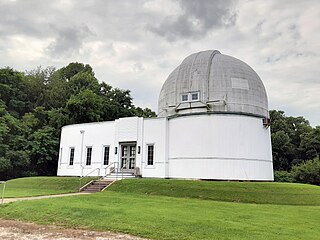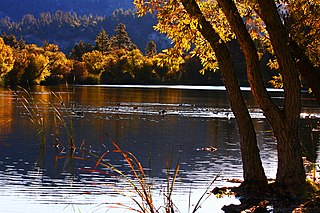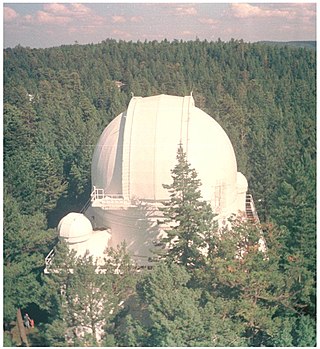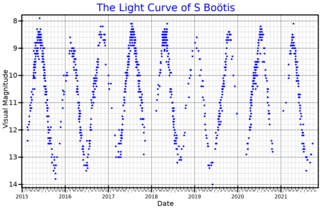Related Research Articles

Sierra de San Pedro Mártir is a mountain range located within southern Ensenada Municipality and southern Baja California state, of northwestern Mexico.
The American Association of Variable Star Observers (AAVSO) is an international nonprofit organization. Founded in 1911, the organization focuses on coordinating, analyzing, publishing, and archiving variable star observations made largely by amateur astronomers. The AAVSO creates records that establish light curves depicting the variation in brightness of a star over time. The AAVSO makes these records available to professional astronomers, researchers, and educators.

Clinton Banker Ford was an American investor, musician and amateur astronomer specializing in the observation of variable stars.

The Angeles National Forest (ANF) of the United States Forest Service is located in the San Gabriel Mountains and Sierra Pelona Mountains, primarily within Los Angeles County in southern California. The ANF manages a majority of the San Gabriel Mountains National Monument.

The Angeles Crest Highway is a two-lane highway over the San Gabriel Mountains, in Los Angeles County, California. Its route is to/through the San Gabriel Mountains National Monument and the Angeles National Forest. With the exception of a 1,000 feet (300 m)-long section in La Cañada Flintridge, the entire route is part of California State Route 2.

The Victor Valley is a valley in the Mojave Desert and subregion of the Inland Empire, in San Bernardino County in Southern California.

The South African Astronomical Observatory (SAAO) is the national centre for optical and infrared astronomy in South Africa. It was established in 1972. The observatory is run by the National Research Foundation of South Africa. The facility's function is to conduct research in astronomy and astrophysics. The primary telescopes are located in Sutherland, which is 370 kilometres (230 mi) from Observatory, Cape Town, where the headquarters is located.

Located in Los Angeles County, California's San Gabriel Valley, the Boy Scouts of America's San Gabriel Valley Council (#40) was one of five councils serving Los Angeles County. It was headquartered in Pasadena.

The Goethe Link Observatory, observatory code 760, is an astronomical observatory near Brooklyn, Indiana, United States. It is owned by Indiana University and operated by the Indiana Astronomical Society https://iasindy.org/about.html, which efforts are dedicated to the pursuit of amateur astronomy.

V606 Aquilae was a nova, which lit up in the constellation Aquila in 1899. The brightest reported magnitude for this nova was apparent magnitude 5.5, making it a naked eye object. It was discovered by Williamina Fleming on a photographic plate taken on 21 April 1899 at the Harvard College Observatory. On the discovery plate, its photographic magnitude was later determined to be 6.75. It was not seen on the plate taken on 1 November 1898, and there were no reported observations of the region around the star during the 171 day interval before Fleming's discovery, so it is possible that the actual maximum of the event was missed. By 27 October 1899 it had faded to 10th magnitude, and on 9 July 1900 Oliver Wendell reported its brightness to be between magnitude 11.5 and 12.0.

Devore Heights, or Devore, is a residential rural neighborhood of the city of San Bernardino, California. It is located just north of the junction of Interstate 15 and Interstate 215, about 12 miles northwest of downtown San Bernardino. It is also the last town to pass through before taking the Cajon Pass to reach Hesperia, California. The area is just outside the boundaries of the San Bernardino National Forest; nearby cities and communities include Verdemont, University Hills, Rancho Cucamonga, Fontana, and Rialto. Glen Helen Pavilion/Amphitheater, the largest amphitheater in North America, is located just south of Devore. Devore is completely within the city's 92407 ZIP Code and is within the 909 and 840 area codes as well.

California's 28th congressional district is a congressional district in the U.S. state of California, in Los Angeles County. The district is regarded as a Democratic stronghold and has been held by the Democratic Party since 2003 and is currently represented by Democrat Judy Chu.

Big Pines is an unincorporated community in Los Angeles County, California, United States. It is in the Angeles National Forest, San Gabriel Mountains.
The Clinton B. Ford Observatory is an astronomical observatory that is operated by the Ithaca College Department of Physics and Astronomy. The observatory is located in the forest on the south end of the Ithaca College campus in Ithaca, New York. It is used by the college for astronomy classes and for student's research projects. It was constructed in 1998 using funds from the National Science Foundation, and a bequest from the late Clinton B. Ford. It houses a CCT-16 16-inch f/8 Cassegrain telescope manufactured by DFM Engineering, Inc. Some electronics were repaired in 2018 through 2022 due to damage by rodents.

The Bridge to Nowhere is an arch bridge that was built in 1936 north of Azusa, California, United States in the San Gabriel Mountains. It spans the East Fork of the San Gabriel River and was meant to be part of a road connecting the San Gabriel Valley with Wrightwood, California.

Table Mountain Observatory (TMO) is an astronomical observation facility operated by NASA's Jet Propulsion Laboratory. It is located in Big Pines, California, in the Angeles National Forest near Wrightwood, north-northeast of Los Angeles, California.

Cloudcroft Observatory, is an astronomical observatory located in the Lincoln National Forest near Cloudcroft, New Mexico, approximately 23 kilometers (14 mi) northeast of Alamogordo. It is owned by the Tzec Maun Foundation, a private astronomical organization.

S Boötis is a Mira variable in the constellation Boötes. It ranges between magnitudes 7.8 and 13.8 over a period of approximately 270 days. It is too faint to be seen with the naked eye, however when it is near maximum brightness it can be seen with binoculars.
Lookout Mountain in Los Angeles County, California, is a 6,812-foot (2,076 m) peak on the shoulder of Mount San Antonio.
Emilia Pauline Pisani (Lee) Belserene was an American astronomer specializing in the observation of variable stars and recognized as an expert on RR Lyrae variable stars. She became known for her work as the director of the Maria Mitchell Observatory in Nantucket and for her biographical writings on Maria Mitchell.